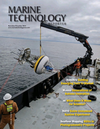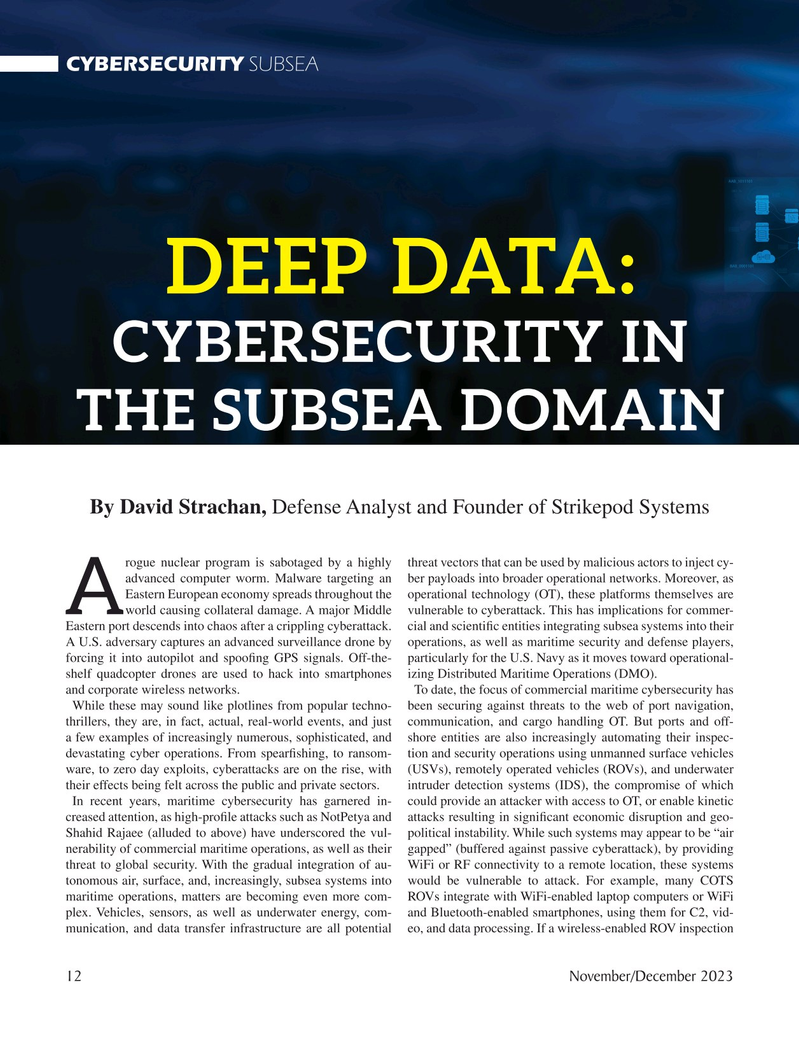
Page 12: of Marine Technology Magazine (November 2023)
Read this page in Pdf, Flash or Html5 edition of November 2023 Marine Technology Magazine
CYBERSECURITY SUBSEA
DEEP DATA:
CYBERSECURITY IN
THE SUBSEA DOMAIN
By David Strachan, Defense Analyst and Founder of Strikepod Systems rogue nuclear program is sabotaged by a highly threat vectors that can be used by malicious actors to inject cy- advanced computer worm. Malware targeting an ber payloads into broader operational networks. Moreover, as
Eastern European economy spreads throughout the operational technology (OT), these platforms themselves are
A world causing collateral damage. A major Middle vulnerable to cyberattack. This has implications for commer-
Eastern port descends into chaos after a crippling cyberattack. cial and scientifc entities integrating subsea systems into their
A U.S. adversary captures an advanced surveillance drone by operations, as well as maritime security and defense players, forcing it into autopilot and spoofng GPS signals. Off-the- particularly for the U.S. Navy as it moves toward operational- shelf quadcopter drones are used to hack into smartphones izing Distributed Maritime Operations (DMO).
and corporate wireless networks. To date, the focus of commercial maritime cybersecurity has
While these may sound like plotlines from popular techno- been securing against threats to the web of port navigation, thrillers, they are, in fact, actual, real-world events, and just communication, and cargo handling OT. But ports and off- a few examples of increasingly numerous, sophisticated, and shore entities are also increasingly automating their inspec- devastating cyber operations. From spearfshing, to ransom- tion and security operations using unmanned surface vehicles ware, to zero day exploits, cyberattacks are on the rise, with (USVs), remotely operated vehicles (ROVs), and underwater their effects being felt across the public and private sectors. intruder detection systems (IDS), the compromise of which
In recent years, maritime cybersecurity has garnered in- could provide an attacker with access to OT, or enable kinetic creased attention, as high-profle attacks such as NotPetya and attacks resulting in signifcant economic disruption and geo-
Shahid Rajaee (alluded to above) have underscored the vul- political instability. While such systems may appear to be “air nerability of commercial maritime operations, as well as their gapped” (buffered against passive cyberattack), by providing threat to global security. With the gradual integration of au- WiFi or RF connectivity to a remote location, these systems tonomous air, surface, and, increasingly, subsea systems into would be vulnerable to attack. For example, many COTS maritime operations, matters are becoming even more com- ROVs integrate with WiFi-enabled laptop computers or WiFi plex. Vehicles, sensors, as well as underwater energy, com- and Bluetooth-enabled smartphones, using them for C2, vid- munication, and data transfer infrastructure are all potential eo, and data processing. If a wireless-enabled ROV inspection 12 November/December 2023

 11
11

 13
13
